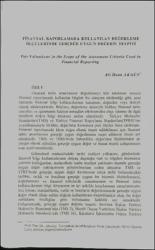Finansal Raporlamada Kullanılan Değerleme Ölçülerinde Gerçeğe Uygun Değerin Tespiti
Abstract
Finansal tablo unsurlarının değerlemeye tabi tutulması sonucu finansal raporlamada kullanılan
bilgiler bu süreçten etkilendiği gibi, aynı zamanda finansal bilgi kullanıcılarının tamamını doğrudan
veya dolaylı olarak etkilemektedir. Böylece, değerleme süreciyle birlikte, finansal tablo unsurları ve
işletmenin faaliyet sonuçları etkilenmekte olup, işletme ile ilgili tarafların doğru bilgi almasına neden
olmaktadır. Türkiye Muhasebe Standartları(TMS) ve Türkiye Finansal Raporlama
Standartları(TFRS)’nın yayınlanmasıyla birlikte, değerleme konusuna yeni ölçüler ilave edilmiştir.
Finansal raporlamada kârın doğru olarak tespit edilebilmesi için finansal tablo unsurlarının gerçeğe
uygun değerlerinin tespit edilmesi önem arz etmektedir. TMS ve TFRS’lerde bahsedilen değerleme
ölçülerinden en yaygın olarak atfedilen gerçeğe uygun değer ve bunun tespiti çalışmamıza esas teşkil
etmektedir.
Geleneksel muhasebedeki tarihi maliyet yaklaşımı, günümüzde finansal bilgi kullanıcılarının
ihtiyaç duyduğu veri ve bilgileri üretmekte yetersiz kaldığından, muhasebede tarihi maliyet yaklaşımı
dışında gerçeğe uygun değer yaklaşımının geliştirilmesine neden olmuştur. TMS ve TFRS’lerde
gerçeğe uygun değer kavramına sıkça atıfta bulunulmakla birlikte, varlık ve borçların gerçeğe uygun
bir biçimde ölçümlenmesi, değerlenmesi ve finansal tablolarda sunulmasının ve finansal tablo
kullanıcılarının bilgi ihtiyacının en iyi şekilde karşılanması amaçlanmıştır. Söz konusu standartlarda,
varlık ve borçların değerlemesinde gerçeğe uygun değer olarak ifade edilen değerin kullanılması
öngörülmekte olup, bu değer varlıkların özelliğine göre birbirinden farklılık arz etmektedir.
Çalışmamızda, gerçeğe uygun değerin tespiti; Stoklara İlişkin Türkiye Muhasebe Standardı’nda (TMS
2), Maddi Duran Varlıklara İlişkin Türkiye Muhasebe Standardı’nda (TMS 16), Kiralama İşlemlerine
İlişkin Türkiye Muhasebe Standardı’nda (TMS 17), Devlet Teşviklerinin Muhasebeleştirilmesi ve
Devlet Yardımlarının Açıklanmasına İlişkin Türkiye Muhasebe Standardı’nda (TMS 20), Varlıklarda
Değer Düşüklüğüne ilişkin Türkiye Muhasebe Standardı’nda (TMS 36), Maddi Olmayan Duran
Varlıklara İlişkin Türkiye Muhasebe Standardı’nda (TMS 38), Finansal Araçlar: Sunum, Değerleme
ve Açıklamalara İlişkin Türkiye Muhasebe Standardı’nda (TMS 32, TMS 39, TFRS 7), Yatırım
Amaçlı Gayrimenkullere İlişkin Türkiye Muhasebe Standardı’nda (TMS 40), Tarımsal Faaliyetlere
İlişkin Türkiye Muhasebe Standardı’nda (TMS 41), Hisse Bazlı Ödemelere İlişkin Türkiye Finansal
Raporlama Standardı’nda (TFRS 2), İşletme Birleşmelerine İlişkin Türkiye Finansal Raporlama
Standardı’nda (TFRS 3), Satış Amaçlı Elde Tutulan Duran Varlıklar ve Durdurulan Faaliyetlere İlişkin
Türkiye Finansal Raporlama Standardı (TFRS 5) bazında ele alınmıştır. Information used in financial reporting is affected by the valuation of financial statement
elements on one hand and directly or indirectly affect all financial information users on the other hand.
By this way, financial statement elements and operation results of the enterprise are affected by the
valuation process, which enables provision of accurate information to the parties related to the
enterprise. With the enactment of Turkish Accounting Standards(TMS) and Turkish Financial
Reporting Standards (TFRS)’s, additional criteria have been introduced in the field of valuation. Fair
valuation of the financial statement elements is of great importance for the accurate profit calculation to be made in the scope of financial reporting. Fair valuation, the most common valuation criteria
specified in both TMS’s and TFRS’s, constitutes the basis of the present study.
Fair value approach has been developed since the historical cost approach adopted in the
traditional accounting fails to produce the data and information needed by the financial information
users. Referred to many times in TMS’s and TFRS’s, fair valuation ensures fair measurement,
valuation and presentation in financial statements of the assets and liabilities and meeting of the
information demand of the financial statement users in the best way. These standards provide for the
use of fair valuations in the valuation of assets and liabilities. Fair valuation changes depending on the
characteristics of the assets. In the present study, fair valuation was discussed on the basis of Turkish
Accounting Standards on Inventories (TMS 2), Turkish Accounting Standards on Tangible Assets
(TMS 16), Turkish Accounting Standards on Leasing Procedures (TMS 17), Turkish Accounting
Standards on Accounting for Government Grants and Disclosure of Government Assistance (TMS
20), Turkish Accounting Standards on Impairment of Assets (TMS 36), Turkish Accounting Standards
on Intangible Assets (TMS 38), Turkish Accounting Standards on Financial Instruments: Presentation,
Valuation and Explanations (TMS 32, TMS 39, TFRS 7), Turkish Accounting Standards on
Investment Property (TMS 40), Turkish Accounting Standards on Agricultural Activities (TMS 41),
Turkish Financial Reporting Standards on Share-Based Payments (TFRS 2), Turkish Financial
Reporting Standards on Business Merge (TFRS 3) and Turkish Financial Reporting Standards on NonCurrent
Assets held for Sale and Discontinued Operations (TFRS 5).
Source
Sosyal Bilimler DergisiVolume
11Issue
2Collections
- Cilt 11 : Sayı 2 [12]



















